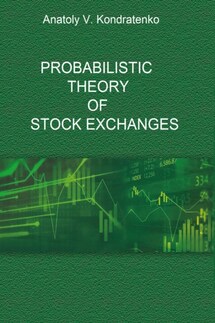Probabilistic Theory of Stock Exchanges - страница 8
We have selected several different assets traded on the Moscow Exchange as the initial objects of our study, for the simple reason that historical data on the trading of these assets have recently been posted on the exchange website, so any researcher can use them to verify the correctness of our calculations. Let us emphasize that these historical data contain almost all quotations of all exchange agents at each moment of time during the whole trading day, not only quotations in a small «cup» near the current market price.
Let us clarify once again: this book represents, in fact, the results of the subsequent development of probabilistic economics, which we developed earlier [Kondratenko, 2005, 2015] for quantitative research of multicommodity multi-agent market economies. This theory in a fairly general form is developed on the basis of one axiom and six general principles that have such a simple and clear logic and rationale under them that they can be considered mandatory for inclusion in any sufficiently adequate economic theory. The way this theory can be used to set and quantitatively solve problems of real economic practice is illustrated in the mentioned works by examples of the simplest model economies, namely one-commodity economies with one buyer and one seller. In the present paper, we show how these theories can be used to quantitatively describe more complex real market economic systems, e.g., highly organized regulated commodity, stock or financial markets with a generally unlimited number of agents, namely exchanges. It turned out that for this purpose it is enough to introduce one more important assumption, namely the equivalence hypothesis, which we will describe further in detail. The good agreement of the calculated exchange prices and trade volumes with the experimental values during the whole day trading session for various assets serves as a direct proof that the theory of exchanges is based on correct principles and hypotheses. The main final result of this work can be considered to be the creation of the organized markets (first of all exchanges) theory fundamentals, the application of which already at the initial development stage has given us an opportunity to shed light on the basic rules governing the functioning of highly organized markets.
Chapter 1
FUNDAMENTALS OF PROBABILISTIC ECONOMICS
"In what follows I have endeavored to reduce the complex phenomena of human economic activity to the simplest elements that can still be subjected to accurate observation, to apply to these elements the measure corresponding to their nature, and constantly adhering to this measure, to investigate the manner in which the more complex economic phenomena evolve from their elements according to definite principles".
Carl Menger [2007]
This chapter describes probabilistic economic theory in sufficient detail, starting from the formulation of the most general statement of the problem to the derivation of the fundamental formulas, using the simplest model of a two-agent economy as an example. To begin with and to avoid misunderstandings and ambiguities, let us repeat once again that, according to the ideology of the physical method, probabilistic economics is a theory that is developed using formal methods of theoretical physics or, in other words, by analogy with how theoretical physics is developed, but, fundamentally, it is an economic theory rather than a physical one, since it studies the structure and dynamics of the economic world, where rules are not in any way directly related to physical laws that describe the structure and dynamics of the natural world. This is already clear from the fact that the subjects of the economic world are people and their actions in the processes of exchange of goods and services, whereas the subjects of the physical world are particles and fields, in particular atoms. And, to be definite, let us also emphasize that this new economic theory was based on the classical concept of supply and demand, that was reinterpreted in the style of modern probabilistic scientific thinking.







